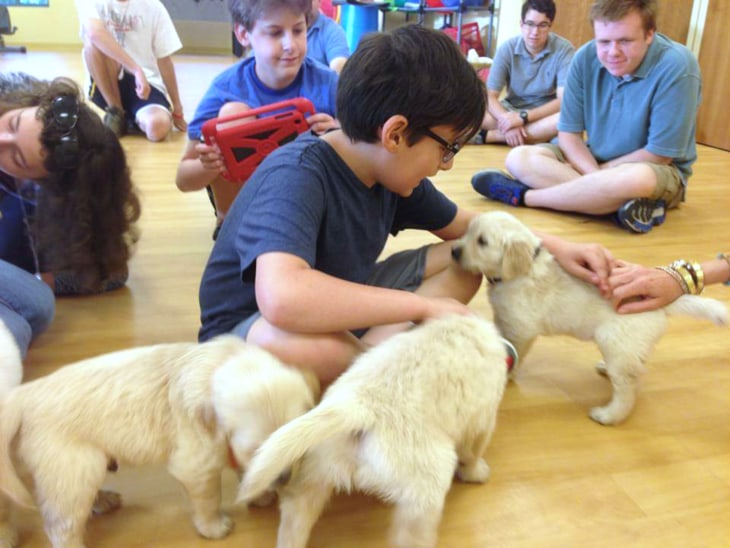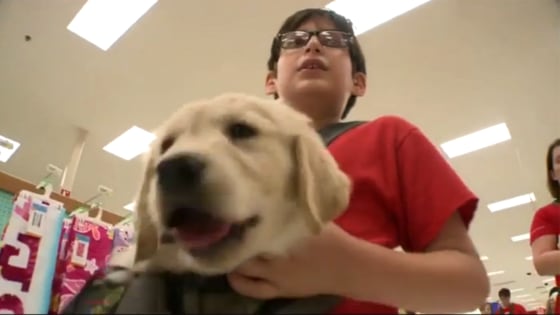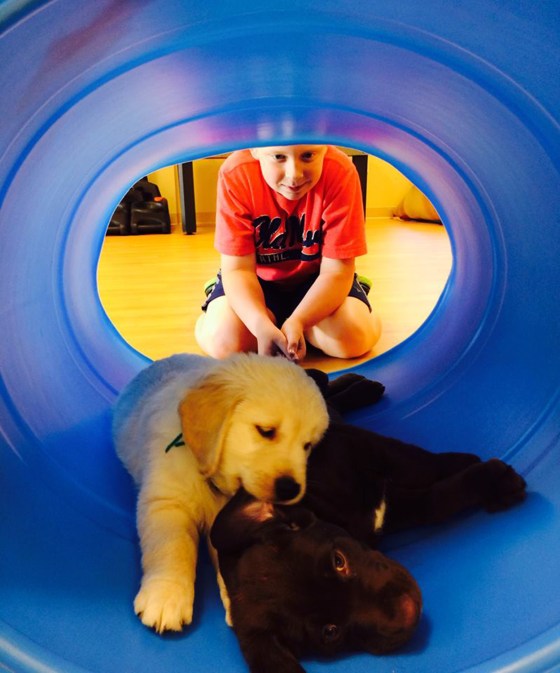
LionPaws via Facebook
Today – Pets By LauraT Coffey – Originally Posted on June 10, 2014 at 4:11 PM ET – Cross Posted at Just One More Pet
A student named Max, front, and other children snuggle and play with puppies at the Lionheart School in Alpharetta, Georgia. The puppies will go on to become service dogs for war veterans and others with disabilities.
For many children with autism, social interactions with strangers can be awkward and anxiety-inducing. But if the stranger is a gentle golden retriever puppy with huge paws and a quiet snore, something remarkable happens.
Throw a puppy into the mix, and the uneasiness tends to melt away.
“It’s just amazing,” said Elizabeth Dulin, co-founder and head of the Lionheart School, which serves students with autism in Alpharetta, Georgia. “When our kids interact with the dogs, we see reduced anxiety levels. ... They become calm and focused.”
One 11-year-old student named Max can quickly identify all seven of the puppies romping around the school. How can he name them so effortlessly when they look so similar? That’s easy.
“Because I love them,” Max told WXIA-TV in Atlanta.

WXIA / 11Alive.com
Max, 11, converses with anyone who will listen about a puppy in his care during a field trip to a Target store.
Lionheart is home base for a new partnership with the paws4people foundation, which trains service dogs for war veterans, disabled kids and adults. Dubbed the “LionPaws Puppy Development Center,” the fledgling program sees to it that the future service dogs help as many people as possible throughout their training.
The puppies spend the first four months of their lives at Lionheart, where they befriend the school’s 39 students. The kids hold the puppies, talk to the puppies, bathe the puppies and go on field trips with the puppies — all the while socializing the animals and preparing them for more advanced obedience training ahead.

LionPaws via Facebook
As this puppy trains to become a service dog, it will touch the lives of many humans in need.
The next stop is an inmate intervention program, where prisoners in good standing teach the puppies 125 commands and train them to open and close doors, turn lights on and off and perform other tasks. Inmates entrusted with the dogs’ training get more than a sense of purpose — they also receive recent job experience that can help them find employment when they get released.
The final phase of the dogs’ training happens at the University of North Carolina in Wilmington, where paws4people is based. Animal-loving students get college credit for making sure the dogs are fully prepared to go to their new homes — often with war veterans who are physically disabled or who have post-traumatic stress disorder.
Related story: 'She gives me independence': Service dog changes wounded veteran's life

LionPaws via Facebook
Getting socialized: Puppies go down a slide with Lionheart students.
paws4people has been training service dogs for 14 years. The newest segment of socialization and training for some puppies — spending time with children with autism — began in January of this year. The results so far have been “nothing short of miraculous,” said Sarah Rosenbaum, director of the LionPaws Puppy Development Center.
Rosenbaum said she’s seen non-verbal children become chatty around the puppies, and she’s seen children with motor-skill deficits get up and run to see the puppies.
“They’re just so excited, which really is such a source of pride for me,” she told TODAY.com. “The children are providing for the puppies, and the puppies are providing for the children.”

LionPaws via Facebook
The puppies get plenty of affection during the first four months of their lives at the Lionheart School.
Lionheart’s first batch of seven puppies is about to move on to the inmate intervention phase of their training, and a new pile of puppies will arrive at the school soon. Five members of the school’s staff have become certified as dog handlers, and that makes it possible for one older service dog named LANGLEY to stay at the school year-round.
Dulin, the head of the Lionheart School, said LANGLEY and the puppies have been helping students to make social and emotional connections. On field trips to Target or to a nursing home, the children often will open up and make conversation with strangers about the puppies. Or when a student is having a bad day, a furry friend can help them regain a sense of normalcy.
“A lot of our kids have difficulty regulating their emotions,” Dulin told TODAY.com. “One little girl who deals with a lot of anxiety was riding in carpool one morning, and a boy who rides with her slammed his finger in the door. This little girl started crying and she could not stop.”
The girl locked herself, wailing, inside a bathroom stall and refused to come out. A teacher knew just what to do: Launch Operation LANGLEY. She brought LANGLEY into the bathroom and sat on the floor until the girl was ready to let the dog into her space.
“About three minutes later, the teacher saw a little ‘thumbs up’ sticking out from under the stall door,” Dulin said. “LANGLEY went into the stall, calmed her down, and then the two walked to class together. And she had been inconsolable — without LANGLEY, we probably would have needed to call her parents.”
Related story: Xena the Warrior Puppy, rescued from abuse, helps 8-year-old boy with autism

LionPaws via Facebook
Puppies take a break while playing with Lionheart students.
Research regarding the effects of companion animals on kids with autism is limited but encouraging. One study published last year revealed that children with autism spectrum disorder were more likely to talk, laugh, make eye contact and show other positive social behaviors in the presence of guinea pigs than they were in the presence of toys.
And in her 2010 paper “What a Dog Can Do: Children with Autism and Therapy Dogs in Social Interaction,” researcher Olga Solomon highlighted cases of dogs helping children to communicate and connect emotionally with others around them. As Solomon noted in her paper, “dogs lead humans elsewhere, and this elsewhere is often better than where we have been before.”
Related:
Pets Reduce Stress at Work… More Companies, Citing Benefits, Allowing Pets at Work
Pets are way better than Therapy!
Pet Alzheimer's Disease - Is Your Dog or Cat Showing Signs?
Therapeutic benefits of music being used to treat Alzheimer’s, addiction, and depression
Sarah Palin and Senator Mile Lee Take Time to Visit Service Dog Trainers While in Iowa
Gov. Palin: Trig is getting a buddy!



 Remember… in the wild they would be eating raw foods and up until a couple decades ago, when some big companies realized they could make money from making and selling commercial pet food, regardless of their nutritional value… commercial pet food, like
Remember… in the wild they would be eating raw foods and up until a couple decades ago, when some big companies realized they could make money from making and selling commercial pet food, regardless of their nutritional value… commercial pet food, like 
 toys that work their brains and their bodies at the same time.
toys that work their brains and their bodies at the same time. 








